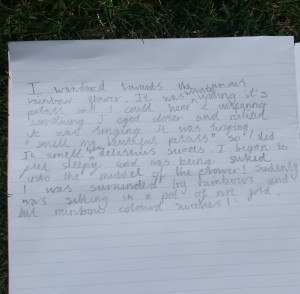Children love the idea of other worlds being out there; imaginary lands that they might one day discover. Some of the most famous children’s books, Alice in Wonderland, The Lion the Witch and the Wardrobe and The Faraway Tree, to name a few of my old favourites, tap into this. These kind of books transcend their historical and geographical context; they span generations, and it is no coincidence that they are still so popular.
As a child, I was a daydreamer, and would often imagine myself away into strange lands, and on weird and wonderful adventures. I would regularly tap the back of my wardrobe when I was putting clothes away…just in case (still do occasionally!) I remember the day when my Grandad (Gang) first showed me the trap door underneath the carpet in the back room. I must have only been five or six at the time and I was fascinated. I couldn’t get my head round the fact that there was a whole other person-sized space secretly hidden away, under our feet. It started a new range of daydreams, imagining trapdoors and tunnels and travelling to secret places.
When children are writing about imagined worlds, there are fewer lovelier ways to begin, and to stimulate their imagination and excitement than to go exploring, trying to find possible portals into their world. It is one of my favourite things to do with them because of the language and excitement it generates, and it never fails to get them eager to start writing. A foot hold on the climbing wall soon becomes a lever, which when pressed, opens up a trap door; the drain pipe becomes a tunnel to another land in the sky; and whatever you do, don’t step on the number five of the hopscotch or you might find yourself hurtling towards cookie land!
It is a great opportunity to model powerful verbs, and whilst the children are jotting down their ideas, I often jot the powerful verbs down separately as we come up with them. I hang them up to serve as a trigger when back in the classroom, or if working in the playground, we might chalk them onto the floor. There is always role-play involved when modelling these powerful verbs; in my opinion essential in consolidating the children’s understanding, plus of course it adds to the fun! The only limit to this exercise is the children’s (and my) imagination, and as always, heaps of discussion and language play an enormous part in generating enthusiasm and ideas, and extending vocabulary.
I love this introduction, written recently, by a usually reluctant, Y4 writer.



